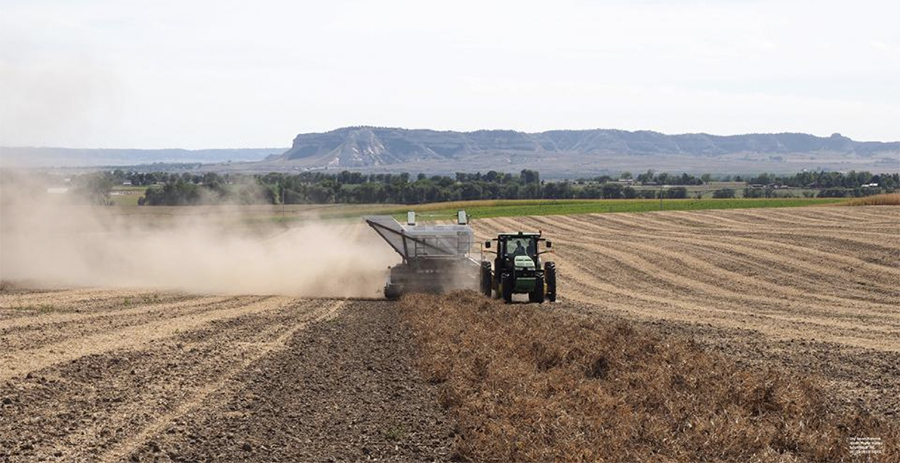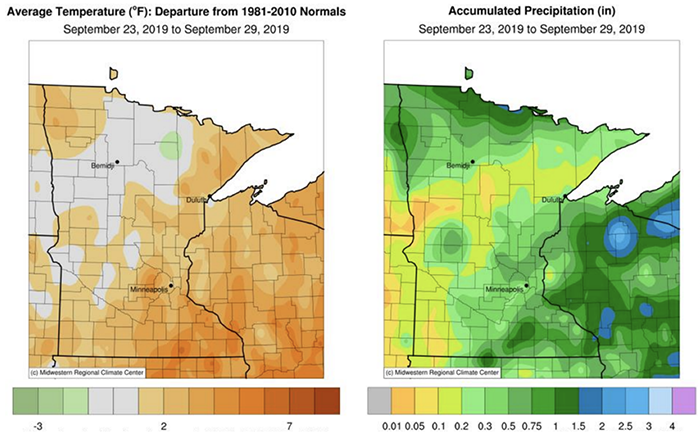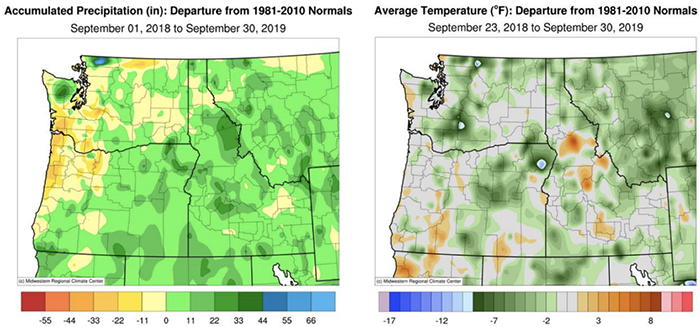October 3, 2019
As the U.S. dry bean harvest picks up, GPC checks in on the top Great Northern bean growing state.


Photo credit: Gary Stone, Nebraska Extension Educator, University of Nebraska Panhandle Research and Extension Center
This year, rains have hampered the harvest of U.S. pulse crops. As of the end of September, harvest progress remains behind the five-year average for all pulse crops. In the major pulse-growing states, the harvesting of peas and lentils is nearly complete, and the dry bean harvest is in full swing. A summary of crop reports from the top pulse-growing states follows at the end of this section.
Additionally, this week we take a closer look at Nebraska, where 80% of the U.S. Great Northern bean crop is grown. This year, the state accounts for 44,500 of the 59,200 acres that U.S. growers seeded to Great Northern beans.
It has been a challenging year for Nebraska farmers. In July, an irrigation tunnel collapsed and left a large expanse of cropland without irrigation. Elsewhere, hailstorms in rapid succession caused significant damage. According to the USDA’s September 30thcrop progress and condition report for the state, the bean crop rated 1% very poor, 8% poor, 27% fair, 57% good and 7% excellent with 71% of the beans harvested and 95% dropping leaves.
Lynn Reuter, executive director of the Nebraska Dry Bean Commission, estimates the harvest is about two weeks behind the normal pace.
“The crop went into the ground in the normal timeframe, but we had a cool start to the summer and didn’t get the heat units in July and August to get the crop growing,” she explains.
As the crop comes off the field, the big question is how it fared without irrigation and in the face of a string of hailstorms.
Judd Keller of Kelley Bean estimates the collapse of the irrigation tunnel impacted some 100,000 acres of cropland, of which 15,000 acres were seeded to beans. Based on reports from that area, yields have been a mixed bag.
“Some growers had major losses, but others are seeing yields of 17 bags, which is pretty good for dryland,” he says.
As for the hailstorms, the area that was hardest hit was the Panhandle, located in northwestern Nebraska.
“We had two storms come through the Scotts Bluff area within nine hours of each other,” Reuter relates.
A few days later, a third storm hit the area. The hail damage is still being assessed, but Keller believes 20 to 25% of the dry bean acres were lost.
“We are going to have lower yields this year,” he sums up. “I would say we are looking at 20 bags or less on beans.”
As processors sort through the rain and hail damaged crops, Keller anticipates electric eyes will be working overtime.
On the positive side, the irrigation tunnel has been repaired. Although it was too late to make a difference for this year’s harvest, it will provide growers with irrigation next year.
Michigan is a key black bean growing state. For the week ending September 29, there were 4.2 days suitable for fieldwork. By the end of the week, dry bean harvest progress had advanced to 19%, behind the five-year average of 46%, with 86% of the plants dropping leaves, which is also behind the average pace of 92% for the date. The crop rated 7% very poor, 16% poor, 24% fair, 37% good and 16% excellent.
Minnesota is the top kidney bean growing state in the U.S. There were 3.9 days suitable for fieldwork for the week ending September 29. The dry bean harvest was at 39% complete by week’s end, behind the average pace of 82%. Ninety seven percent of the plants were dropping leaves, on par with the five-year average. The crop rated 1% very poor, 9% poor, 23% fair, 58% good and 9% excellent.

Montana is a major producer of pulse crops. Last week, a historic snowstorm hit the state, dumping nearly two feet of snow in Ponderosa County. Crop damage is being assessed. Additionally, rains continued to hamper harvest progress and deteriorate crop quality. By the end of last week, 95% of the lentils had been harvested, 96% of the peas and 85% of the beans (including chickpeas).
North Dakota is the country’s top dry bean producing state. There were three days suitable for field work the week ending September 29th. The dry bean harvest advanced to 39% complete, behind the average pace of 72%. Ninety six percent of the plants were dropping leaves. The crop rated 2% very poor, 9% poor, 33% fair, 51% good and 5% excellent. Lentil harvest progress was at 73%.
The Pacific Northwest is an important pulse producing region. In Idaho, there were 5.9 days suitable for fieldwork last week. Conditions were favorable for harvest progress until a storm hit late in the week. The wet weather delayed the chickpea harvest in Benewah County. The dry bean harvest advanced to 63% complete, behind the five-year average of 84%. Oregon also had 5.9 days suitable for fieldwork last week, with a mix of rain and snow reported over the weekend. Dry bean harvest progress was at 80%.
Washington had 4.1 days suitable for fieldwork, with snowfall in some areas. The dry pea harvest was 91% complete, behind the average of 100% for the date. Dry bean harvest progress was at 66% complete, behind the average pace of 92%.

Disclaimer: The opinions or views expressed in this publication are those of the authors or quoted persons. They do not purport to reflect the opinions or views of the Global Pulse Confederation or its members.